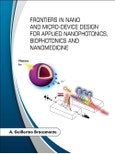It explains how nanodevices and microdevices can be used for nanophotonics, biophotonics and drug delivery applications. Advanced biochemical techniques ranging from fluorescence, plasmonics, enhanced plasmonics (EP) to metal enhanced fluorescence (MEF) from colloidal dispersion to single luminescent nanoplatforms and nanospectroscopy, microfluidics, nanofluidics, silica wave-guiding, lasers, nanolasers and photonic circuits for enhanced signal detections are also presented. In addition, proof of concept ideas of microdevices and nanodevices to real applications within other allied disciplines such as genomics, biochemistry, drug delivery and clinical chemistry (based on advanced optical detection and imaging) are highlighted.
The book is an informative reference for readers studying biochemistry, pharmacology, biomedical engineering and related subjects at all levels, as well as general readers who want to learn about advanced applications in optics and photonics.
Table of Contents
Chapter 1 Introduction to the Basis of Micro- and Nanodevices Design 11. Introduction
- Concluding Remarks
- References
Chapter 2 Control of the Nanoscale Concepts
1. Control of Nanoparticle Size
2. Synthesis, Type of Reactions and Nanomaterials in Organized Media
3. Effect of Size and Interaction
4. Chemical Surface Modification
5. Plasmonics in the Near Field and Frontiers in the Quantum Regime
- Concluding Remarks
- References
Chapter 3 Design, Synthesis and Tuning of Advanced Nanomaterial
1. Concept of Tuning of Nanomaterial
2. Organic Nanocomposite
3. Polymeric Nanomaterial
4. Inorganic Nanomaterial
5. Hybrid Nanoarchitecture
6. Metamaterial
- Concluding Remarks
- References
Chapter 4 Classical and Non-Classical Light Generation Within The
- Near Field
2. Metal Enhanced Fluorescence (Mef)
3. Fluorescence Resonance Energy Transfer (Fret)
4. Coupled Phenomena (P-Fret; Mef-Fret; Ep-Mef)
5. Enhanced Quantum Emitters
- Concluding Remarks
- References
Chapter 5 Developments in Nanophotonics
1. Developments in Nanophotonics
2. Ultraluminescent Functional Nanomaterials
3. Enhanced Ultraluminescent Multilayered Nanoplatforms
3.1. Nanolasers and Nanoantennas
3.2. Supramolecular Nanoparticles
3.3. from Single Nanoparticle Spectroscopy to Nanoarray Analysis
- Concluding Remarks
- References
Chapter 7 Signal Detection Waveguiding
1. Introduction
2. Materials Used for Waveguide Fabrications
3. Applications
- Concluding Remarks
- References
Chapter 8 Design of Nano and Micro-Devices
1. Design and Fabrication of Lab-On Particles and Chips
- Concluding Remarks
- References
Chapter 9 Nano-Optics, Photonic and Quantum Circuits
1. Concepts of Quantized Photon Interactions with Nanomaterials 86
2. Photonic Surface Modifications
3. Design of Subwavelength Circuits and Applications
- Concluding Remarks
- References
Chapter 10 Optosensors and Optrodes
1. Introduction to Optodevices
2. Development of Optosensors and Optrodes
- Concluding Remarks
- References
Chapter 11 Biophotonics at Single-Molecule Detection (Smd) Level
1. Single-Molecule Detection
2. Plasmonic Nanoplatforms for Smd
3. Supramolecular, Dna-Based and Other Smd Approaches
4. Optical Tweezers
- Concluding Remarks
- References
Chapter 12 Miniaturized Microscopes
1. Introduction
2. Versatility and Applications of Miniaturized Instrumentation 107
- Concluding Remarks
- References
Chapter 13 Neurophotonics
1. Introduction
2. Labelling Techniques
3. from Basic Research to Advanced Methodologies for Brain Imaging
4. Miniaturized Instrumentation for in Vivo Implantable And Portable Devices
5. Neuro-Signaling Tracking
Chapter 6 In-Flow Methodologies
Chapter 14 Precision Nanomedicine Based on Genomics and Drug Delivery Systems
1. Introduction
2. New Advanced Diagnosis Based on Lab-On Particles
3. Lab-On Chips
4. Genomics and Miniaturized Analysis
5. Targeted Drug, Cargo Nanoparticles and Implantable Devices For Controlled Administration
6. Gene Therapies and New Targeted Delivery Systems
- Concluding Remarks
- References
Chapter 15 State-Of-The-Art Technology
- References
- Concluding Remarks
- References
- Subject Index
Author
- A. Guillermo Bracamonte








